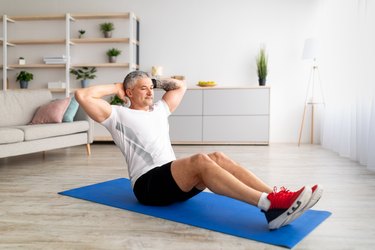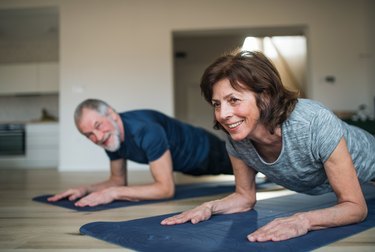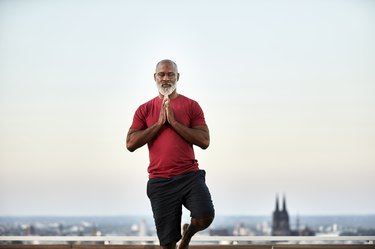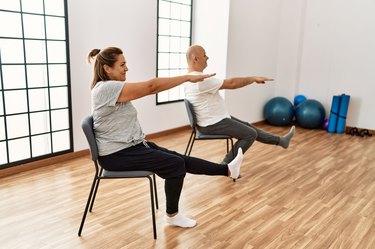
Starting an exercise routine for the first time or coming back from a long break can be tough. But body-weight exercises are an excellent choice for anyone — but especially older adults — to build all-around strength, stamina, balance and mobility.
Body-weight moves use your own weight to provide resistance, all while protecting your bones and joints, which is particularly beneficial for older adults because as you age, you tend to lose bone mass and cartilage, according to Mount Sinai.
Video of the Day
Additionally, a small April 2021 study in Experimental Gerontology that examined the effects of body-weight and resistance band training on older adults found improvements in muscle function and body composition. Muscle strength and function is important for daily activities like carrying groceries or lifting a heavy box off the floor.
What's more, you can perform body-weight exercises nearly anywhere, and they require no special equipment that might otherwise cost a lot of money or require a high skill level.
How to Do This Workout
This 10-minute body-weight workout is made up of two rounds of exercises. Perform the exercises in round one 2 to 3 times through, resting 20 to 30 seconds in between each exercise. When you finish round one, rest 30 to 60 seconds.
Then perform the exercises in round two 2 to 3 times through, resting 20 to 30 seconds in between each exercise. The amount of reps per exercise is listed below.
Round 1
1. Triceps Push-Up
- Position yourself on your hands and knees, hands under shoulders and knees under hips.
- Step your feet back and straighten your legs so you're balanced on your palms and toes in a high plank position.
- Your body should make a straight line from head to hips to heels, and your hands should be directly under your shoulders.
- In a slow and controlled manner, bend your elbows to lower your chest toward the floor. Your arms should remain parallel to your sides with your elbows pointed backwards.
- Press into your palms and push the floor away from you to come back up to a high plank, still keeping your body in one straight line.
Tip
If this exercise is too challenging, you can modify it by putting your hands on an elevated surface like a coffee table, a stable chair or a stair.
2. Bench Lunge
- Stand a few feet in front of a bench, box or chair, facing away from it.
- Reach your left foot back and place the top of your foot flat on the surface. To help with balance, widen your base of support by moving your left foot a few inches to the left.
- Raise your arms out to your sides until they reach shoulder height for balance.
- Lean your torso forward slightly and bend your front knee to sink your hips toward the floor as low as you can comfortably go. Keep your front knee behind or in line with your front toes.
- Your front-leg shin should be vertical or close to it, while your back knee should point down toward the floor. If either leg is out of place, move your front foot forward or backward until you’ve found the ideal positioning.
- Push through the middle of your front foot to return to standing. Avoid pushing into your back foot.
- Repeat.
- Complete all reps on one leg before switching to the other.
3. Reverse Plank
- Sit on the ground with your legs extended. Place your hands on the ground slightly behind you. Point your fingers toward your feet.
- Drive your heels into the ground and lift your hips up into alignment with your legs and chest. Rest on your heels and palms, fingers spread.
- Your body should form a straight line from shoulders to hips to feet. Your hands should be directly under your shoulders.
- Gaze straight up toward the ceiling. Keep your chin off your chest, but make sure that your head isn’t collapsing toward the floor.
Round 2
1. Leopard Crawl
- Begin on all fours with your hands and knees on the floor.
- Curl your toes under and push through your hands and toes so your knees come off the floor an inch or two. Keep your core engaged and hips level so you don't stick your butt into the air.
- Crawl forward with your right hand and left foot.
- Then, crawl with your left hand and right knee.
- Continue to crawl forward, alternating sides, 4 times.
- Reverse the motion to crawl backward, alternating sides, 4 times.
- Continue crawling forward and backward for 25 seconds.
2. Hollow Hold
- Lie down on your back on the floor or on an exercise mat and press your lower back down into the ground.
- Squeeze your navel down toward the floor to activate your abdominal muscles. Make sure your legs are glued together as you gently raise them up off the ground.
- Float and extend both arms overhead and gently raise your head and shoulders off the floor, keeping your arms by the side of your face.
- Keeping your lower back flush against the floor, hold this position for 25 seconds. Think about pulling your bellybutton into the ground.
- Avoid tucking your chin in toward your chest. Instead, gaze down your body at your feet.
Tip
If, while initially performing the hollow hold, you have trouble keeping your lower back on the floor, adjust the exercise to begin with your feet planted and your arms extended toward them rather than over your head. As you build core strength, you’ll eventually be able to assume the full starting position.
- Mount Sinai: "Aging changes in the bones - muscles - joints"
- Experimental Gerontology: "The effects of a combined bodyweight-based and elastic bands resistance training, with or without protein supplementation, on muscle mass, signaling and heat shock response in healthy older people"
- Clinical and Experimental Hypertension: "Acute effect of bodyweight-based strength training on blood pressure of hypertensive older adults: A randomized crossover clinical trial"
Was this article helpful?
150 Characters Max
0/150
Thank you for sharing!
Thank you for your feedback!


